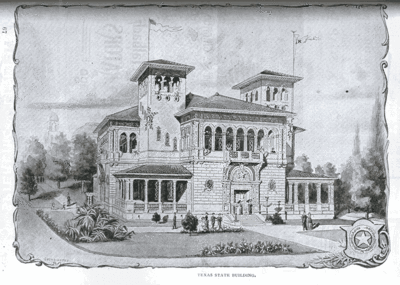24 January 2006 - Tuesday
Texas at the World's Fair

Yesterday, as part of some recent research concerning the Chicago World's Fair of 1893, I retrieved The Official Directory of the World's Columbian Exposition (Chicago: W. B. Conkey Company, 1893) through an interlibrary loan. Browsing the pages of the hefty blue book, I ran across an article touting Texas' exhibit at the fair. The entry amused me because it exemplified a combination of characteristics that any present-day Texan will recognize -- effusive state pride, annoyance at the labyrinthine constitution, and frustration at the legislature's perceived inability to appropriate money to the satisfaction of its constituents.
More than anything else, the listing was an apology for the modesty of the exhibit, which was thought inappropriate to the great state of Texas. I have inserted paragraph breaks for the reader's ease:
Texas has erected a handsome building on the right of the north entrance to the Exposition grounds, and this notwithstanding the failure of the State Legislature to make an appropriation on account of constitutional prohibition. The money for the structure was raised by the Women's World's Fair Exhibit Association of Texas, with headquarters at Austin, the State capital.The Texas Building cost $30,000.General regret was expressed when the solons of the Lone Star State failed to make a suitable appropriation for the representation of the resources of that great commonwealth. Mr. John T. Dickinson, the efficient secretary of the National Commision, is a resident of Texas, and he did all in his power to bring about a more favorable and extensive exhibit from his native and beloved State. He wrote numerous articles for the Texas newspapers, traveled and spoke all over the State, induced other prominent Exposition officials to help him in the work of creating a sentiment which would crystallize into favorable action by the law-making powers, and was materially aided in his efforts by numerous prominent citizens of Texas, but to the chagrin and disappointment of thousands of progressive and enterprising Texans, as well as to [sic] their numerous friends all over the country, the appropriation failed to pass, and Texas, once an entire republic itself and now one of the finest, best and most progressive in the galaxy of the States of this union, is not represented at the Fair in such manner as becomes its grandeur. All credit, however, to the noble band of ladies of the Exhibit Association for what Texas has to show.
In the treatment of the design of the Texas Building the architect has not deflected from the history of the Lone Star State, which, from its foundation, has been marked by a Spanish tinge, whose architectural inclination and handsome botanical effects lay down a chain of thought far too beautiful to be forsaken for that of the present day; therefore, the building was designed for colonnades, grounds, fountains, foliage, etc. It contains an assembly room 56 feet square, 28 feet high, provided with art glass skylight in the ceiling, with a mosaic Texas star in the center. The rostrum, ante-rooms, etc., are furnished in the natural woods of Texas. One wing contains rooms for bureau of information, register, messenger, telephone, telegraph, directors, Texas Press Association headquarters, commissioners, historical museum and library, toilet rooms, county collective exhibits, etc. The main entrances are through vestibules, flanked on either side by niches and colonnades. The main vestibules terminate in a large auditorium, connecting with the rooms mentioned.
This contrasts dramatically with the bland entries of most other states (although host state Illinois, naturally, got a much longer article for its $250,000 building). I shall take Maryland's report, in its entirety, as a convenient example:
The Maryland Building is near the lake and opposite the Virginia Building. It is a handsome structure and is divided into reception hall, ladies' toilet, ladies' parlor, exhibition hall, woman's department, bureau of information and main exhibition hall, beside spacious porches on the first floor. Gents' toilet, office, smoking room, reading room, and three parlors which communicate constitute the second floor, and a gallery overlooking the main exhibition hall is entered from this floor. The flat deck roofs of porches and buildings offer fine points of vantage for overlooking the grounds of the World's Fair.Wusses. I bet they didn't even have colonnades.
| Posted by Wilson at 11:50 Central
| TrackBack
| Report submitted to the Humanities Desk
